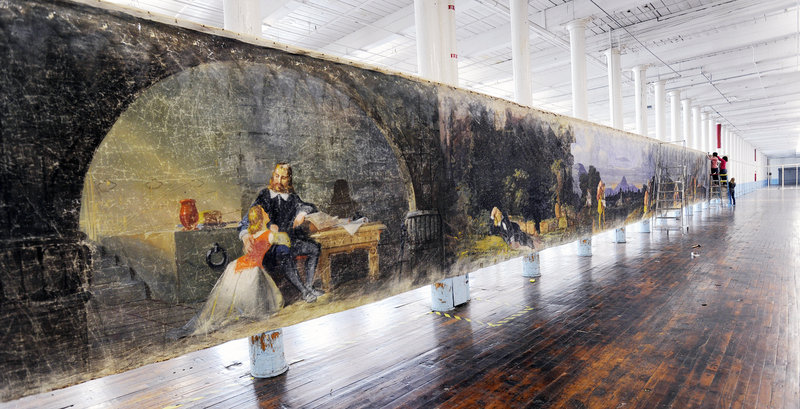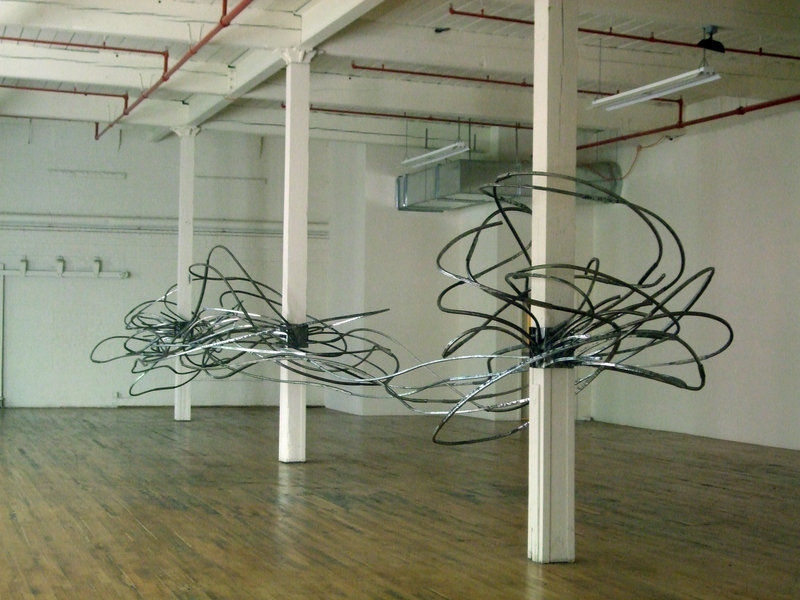When you think of venues for fine art in Maine, a few robust images bubble up to the surface: quaint old storefronts in seaside villages, Victorian commercial spaces either in rural homes or on the granite-lined and cobbled streets of Portland, with its sweetly wide-eyed Beaux-Arts aspirations. There are also a few architectural gems such as I.M. Pei’s Portland Museum of Art; McKim, Mead and White’s Bowdoin Art Museum; and, soon, Colby’s new Frederick Fisher-designed space.
More and more, however, art in Maine is being associated with large mill spaces. While this has more to do with trends in real estate development than any motion from the art world, it has a real effect on what we are seeing and how it is presented.
Two new shows in mill spaces — one mostly in Biddeford’s Pepperell Mills and the other in Brunswick’s Fort Andross — present a deliciously poignant set of contrasts between contemporary and 19th century ideas about art, space and public entertainment.
The Saco Museum’s exhibition of 800 linear feet of the 1851 moving panorama of “The Pilgrim’s Progress” is an extraordinary event. Basically, it’s a giant painting that was scrolled on huge spools of canvas in a theater with accompanying narration and music. Such moving panoramas were among the most popular forms of public entertainment, so hundreds of them would be touring the United States and Europe during any given moment of the second half of the 19th century.
Bizarrely, this most popular form has been almost completely expunged from our cultural memory. Yet by chance, of the huge number of panoramas produced, the Saco Museum’s “The Pilgrim’s Progress” — which reflects the work of such painting greats as Jasper Francis Cropsey and Frederic Edwin Church — is one of the most significant remaining examples of them in the world.
I am not sure if it’s apt or ironic to see “The Pilgrim’s Progress” exhibited not as it was intended to be shown (more like a movie, which had yet to be invented) but as a single continuous canvas flowing along the giant structural beams of a gargantuan open mill space where many thousands of our forebears toiled over fabric looms for countless hours.
“The Pilgrim’s Progress” is narrative, Christian, moralistic and melodramatic to the nth degree. And, of course, it was wildly popular during the years it toured America.
It blew me away to see Isabelle Pelissier’s “In-Flux” on the same day as “The Pilgrim’s Progress.”
“In-Flux” is a large-scale, essentially abstract sculpture made of square steel tubing mounted to (and actively engaged with) three of the structural columns in the Coleman Burke Gallery’s huge space in the Fort Andross Mill.
The steel strands bend and swoop among and around the huge old wooden beams — to which they are attached at about 5 feet off the ground by two-part steel mounts. The mount sites are complex and interesting, although it’s disappointing that such important elements are held together by cheap-looking long-bolts when everything else has a hand-worked feel. In fact, the aesthetic of the steel is wonderfully satisfying: It was cold-bent and loosely polished by a sander — most likely to chase away any rust.
While the tubes generally follow gently organic curves, Pelissier’s hand in bending them is very clear. This makes it feel like art — and drawing in particular — rather than some futuristic machine. Ironically, it also pulls in the viewer to see it from an intimately human distance. This has the fantastic effect of making you feel like you are either beside or even within a whitewater stream. With your head comfortably above the fray between the mill-building columns, it twice offers the sanctuary of breathing space which, in turn, punctuates the dangerously exciting splash-currents at the poles.
While “In-flux” is experientially successful from up close, it works in a very different way from a distance. The gallery is next to the Frontier Cafe space, whose vast windows look out over the frothing falls of the churning Androscoggin. With the line of the sculpture/installation/drawing matching the Androscoggin, your body cannot help but make the connection to the river.
While the river connection of the work is obvious, it might not be if the piece were installed somewhere else. I think Pelissier deserves credit for some compelling subtlety. It’s an easy piece to like and admire, but I think it’s too easy not to notice the interaction of the piece with the architecture, the building’s history and the riverside site. Pelissier mobilizes all of these so gracefully that it doesn’t feel like the intellectual accomplishment that it is.
Pelissier also includes a set of drawings very casually stapled up to the wall. They are long strips of paper that have been folded twice (like a slender “Z” with a short mid-section) over which Pelissier forced a series of extended pencil lines. The lines are fat and quick and leave concussion marks where they hit the folds, which are on the lower segment of the paper that leans out from the wall.
These smart drawings reveal a great deal about Pelissier’s conceptual process which appears to be more meditative than verbally intellectual. It might seem ironic that Pelissier’s current metaphor is a narrative model while “The Pilgrim’s Progress” is a narrative geared towards emotional sentiments rather than story. Yet this has everything to do with the difference between Victorian and modern art. Abstraction didn’t exist 150 years ago. There wasn’t conceptual art. And Modernism hadn’t been invented yet.
Entertainment has always reflected our spiritual selves, but at some point, art became about here-and-now instead of the great Hereafter. Our Maine mills are part of who we are, but they are different now. And so are we.
Freelance writer Daniel Kany is an art historian who lives in Cumberland. He can be contacted at:
dankany@gmail.com
Copy the Story Link
Send questions/comments to the editors.




Success. Please wait for the page to reload. If the page does not reload within 5 seconds, please refresh the page.
Enter your email and password to access comments.
Hi, to comment on stories you must . This profile is in addition to your subscription and website login.
Already have a commenting profile? .
Invalid username/password.
Please check your email to confirm and complete your registration.
Only subscribers are eligible to post comments. Please subscribe or login first for digital access. Here’s why.
Use the form below to reset your password. When you've submitted your account email, we will send an email with a reset code.